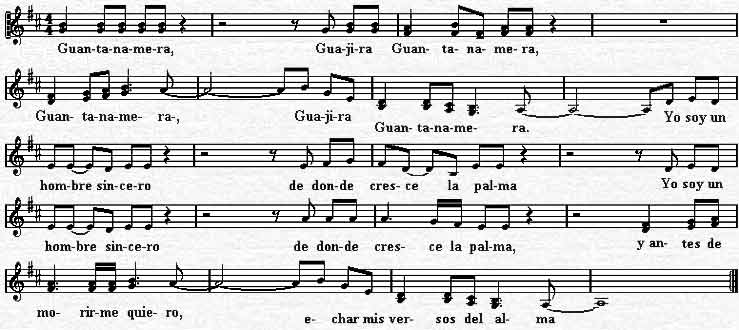10.5 La Guantanamera. A work of great significance in 20th-century Cuban music (1930–1958).

La Guajira Guantanamera is a well-known musical work of great significance within the repertoire of Cuban music.
This Guajira-Son was composed by Joseíto Fernández in 1928, and a decade later it began to gain popularity when Alejandro Riveiro used it as his orchestra’s farewell theme. Its refrain, or montuno, repeats: “My beautiful guajira/Guantanamera guajira.” It is a peculiar tune; its improvisations did not follow the traditional son form like the quartets or “reginas,” but rather the seguidilla form, with a structure of several uninterrupted décimas (tenths), which made it possible to sing or narrate historical and social events or happenings.
In 1943, a Cuban radio station exclusively hired Joseíto Fernández, with the intention of his creation being a daily feature on a program popularized and featured in the daily crime report, which featured the song’s chorus. This radio program ran for 14 years and enjoyed a very high audience. When the program ceased broadcasting, La Guantanamera declined from its previous popularity, although it continued to be remembered by the Cuban people.
At the Peña of Asturian musician Benjamín Orbón, José Martí’s Versos Sencillos (Simple Verses) were first introduced in the melody of this work. Héctor Angulo, a member of the peña and his student, traveled to the United States around 1959, and at a summer camp sang the Guajira Guantanamera, which is how Pete Seeger came to know it.
On June 8, 1963, La Guantanamera became internationally known when American singer-songwriter Pete Seeger performed a version of it, which included several of José Martí’s Versos Sencillos, at Carnegie Hall in New York.
Another recording of this song was made in 1965, by an American trio that added rock elements. These recordings by La Guantanamera made it a true international success and a success in this field.
This composition has been featured in various Cuban music concerts, which have been performed on numerous stages around the world. It has also been recorded by countless Cuban and international musicians, and features vocal and instrumental performances. Critics regard it as a true symbol of Cuban identity.








